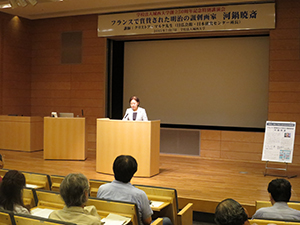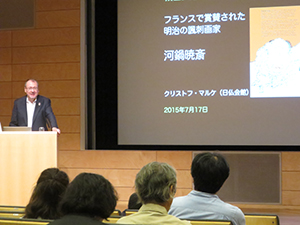- HOME >
- NEWS >
- Josai Hosts Keynote Lecture on “Meiji Satirical Artist Kyosai Kawanabe Who Was So Celebrated in France” as Part of 50th Anniversary of University’s Founding


On July 17, 2015, Josai University Educational Corporation hosted a special keynote lecture on “Meiji Satirical Artist Kyosai Kawanabe Who Was So Celebrated in France.” This lecture was organized as a part of the festivities celebrating the 50th anniversary of Josai’s founding. The keynote speaker was Christophe Marquet, director of the Maison Franco-Japonaise Institut français de recherche sur le Japon and was attended by 160 “Kyosai fans,” including students and faculty.
Kyosai Kawanabe (1821-1889) was a nonconforming artist who lived from the closing days of the Tokugawa period into the Meiji period. In 1870 (Meiji Year 3), Kyosai was the subject of political controversy for his work, an incident that demonstrates his deep spirit of defiance. As such, he left behind numerous caricatures and satirical paintings. While his work is considered an extension of the Kano school, he voraciously incorporated a number of styles and methods, calling himself the “devil painter.” And though that gifted brushstroke and power of depiction distinguished him from the crowd, Kyosai remained a largely forgotten artist in the Japanese art world until recently. In Europe, on the other hand, Kyosai has been considered a major representative of Japanese art and a successor of the Hokusai tradition since the late 19th century.
Before the lecture, Josai University Educational Corporation Chancellor Noriko Mizuta provided opening remarks. “Mr. Marquet is someone who has channeled much energy into the study of Japan-France cultural exchange as well as the cultivation of human resources. For students of our university, whose education program bears the slogan ‘Japan in the World,’ Mr. Marquet’s lecture should prove to be an excellent learning opportunity.”

Chancellor Mizuta provides opening remarks
Keynote lecturer Christophe Marquet was born in France in 1965. A specialist in early-modern and modern Japanese art history and print culture, Mr. Marquet has edited several volumes including Probing Japanese Textual Culture―From a Japanese-French Perspective and Weaving Text and Image―Japanese-French Exchange in Publishing Culture. In France, many translations and reissues of collections by Edo and Meiji era artists such as Hochu Nakamura, Hokusai Katsushika, Utamaro Kitagawa, and Kyosai have been published. This includes a translation/reissue of Kyosai’s posthumous works, entitled Kyôsai hyakki gadan; L'histoire illustrée des cent demons.
Mr. Marquet’s project surveys French museums and archives in search of “traces of Kyosai.” Using slides taken from these visits, Mr. Marquet extends the question of “when and why Kyosai became so famous in France.”

Mr. Marquet during his lecture
Kyosai’s work was first introduced to France through the publication of Promenades Japonaises in 1880 by French businessman Émile Étienne Guimet ―who came to Japan as part of a religious survey―and artist Félix Régamey. This led to the high evaluation of Kyosai as a satirical artist in France. Mr. Marquet also introduced picture collections from the Musée Guimet archives as well as cover illustrations from famous French journals. “With his three month imprisonment following the writing controversy, Kyosai’s image in France as a ‘defiant artist’ was solidified. Without being overshadowed by their European counterparts, this fulfilled the high evaluation of a Japanese sense of beauty,” explained Mr. Marquet. He then showed the obituary published on the front page of Le Figaro following Kyosai’s death to demonstrate the overwhelming admiration France had for the artist.
Curators from the Musée Guimet, and members of the Groupe Economique Franco-Japonais and France-Japan Women’s Association filled the lecture hall. Associates from the Mitsubishi Ichigokan Museum where a Kyosai exhibit is currently on display were also in attendance.
